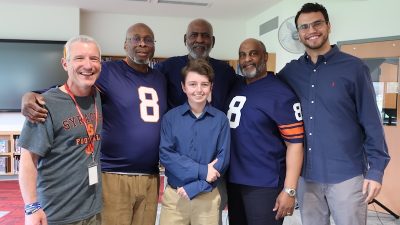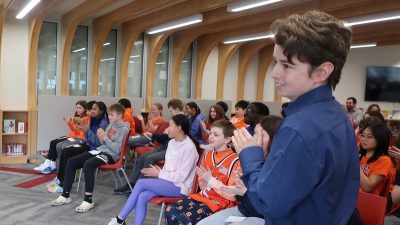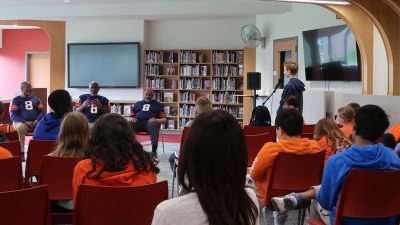Three members of the Syracuse 8 surprised Jamesville-DeWitt middle schoolers on April 19, 2024, the 54th anniversary of their historic boycott, to wrap-up the students’ special unit on “Social Justice Changemakers.”

The special curriculum examined the football players’ courageous stance against institutional racism. Syracuse University School of Education student Nick Trivelpiece ’26 and School of Information Studies alumnus Alex Tsemberis ’21 developed the lessons, which were incorporated across the district’s sixth-grade English Language Arts classes and taught in Andrew Starowicz and Sophie Leo’s class across the previous five school days.
Greater Depth
Since graduating, Tsemberis—who wrote his honors thesis on the Syracuse 8 and who is working in ethical AI as a technology consultant at Ernst & Young—has collaborated with members of the group to add greater depth to his research.
Over the past three years, he has collected archival material and interviewed more than 30 people. He and Professor Jeffery Gonda, of the Maxwell School of Citizenship and Public Affairs, are co-authoring an academic article further examining the boycott. The Syracuse University Special Collections and Research Center at Bird Library has been instrumental in supporting the paper’s progress.
Trivelpiece learned about the Syracuse 8 when Tsemberis presented his research to undergraduates in an honors course taught by Dr. Sally Wagner. Given his Selected Studies in Education major, Trivelpiece decided to work on a Syracuse 8 curriculum for his honors course final project.
As part of this project, Trivelpiece reached out to Starowicz—his former teacher—who agreed to have Trivelpiece and Tsemberis teach the curriculum in his class.
A Lot of Integrity
On the rainy morning of April 19, Greg Allen ’73, John Lobon ’73, and A. Alif Muhammad ’71 arrived shortly after the first bell and were hurried into the faculty lounge attached to the school’s library.
“As Greg stated, we call it a gift we gave the University because we opened the door, and we stood in the door to say: ‘No one else should ever have to go through this again.’”
John Lobon
Meanwhile, approximately 45 sixth-graders, donning Syracuse Orange gear, filed into six rows of chairs set up for the unit’s final session. Many held prepared questions and had started to whisper about what the special surprise might be.
As the three were welcomed, additional guests joined them. Robert Drummond ’89—a Jamesville-DeWitt graduate and former standout running back at Syracuse in the late 1980s—attributed the sacrifices of the Syracuse 8 as the reason he was able to play for the Orange and go on to a 15-year National Football League career, starting with his 1989 NFL Draft to the Philadelphia Eagles.
“Without them,” Drummond began, “there would be no me.”
Next, Syracuse’s new head football coach Fran Brown shared how the Syracuse 8 served as a personal inspiration. “These guys have a lot of integrity,” Brown said. “They stood up and actually put their own careers to the side for me to have the opportunity to be a football coach one day.”
A Gift to the University

The Syracuse 8 is comprised of nine student-athletes; eight of whom boycotted football practice in April 1970 until their demands to the University were met.
They are Greg Allen, John Lobon, Alif Muhammad (formerly Al Newton), Richard Bulls, John Godbolt, Dana “D.J.” Harrell, Clarence “Bucky” McGill, Duane Walker, and Ron Womack (Womack was unjustly declared medically ineligible to play in 1969; he was formally recognized as a member of the Syracuse Eight in 2006 by Chancellor Nancy Cantor).
Their bravery came at significant personal cost to any future NFL careers they might have had, but their efforts left a lasting mark on the University, making the institution become a more just and equitable place.
Allen explained this background to the middle schoolers by first reflecting on the University’s 1870 founding principle that states, “There will be no invidious discrimination.” He told the students that meant treating someone unequally for no reason.
According to Allen, the boycott—which occurred a full century after the University’s founding in 1870—pulled the institution back on mission, one based on social justice principles: “We got an ocean liner to change direction and get back on course.”
“Without them, there would be no me.”
Robert Drummond ’89
The choice to boycott was ultimately a sacrifice, but all three Syracuse 8 members present agreed it was one based on their moral compasses. “It came to a choice of whether we give it up or whether we continue,” said Lobon. “It was the right time at the wrong time.”
“As Greg stated, we call it a gift we gave the University,” Lobon continued, “because we opened the door, and we stood in the door to say: ‘No one else should ever have to go through this again.’”
“What we did wasn’t for self, but was for you,” Allen added. “We knew that when we made that choice, we wouldn’t benefit, but others would at a later date.
“And you’re the later date,” Allen told the students.
Know the Changemakers

Seeing the culmination of their efforts on the special curriculum was “surreal,” said Trivelpiece at the conclusion of the event.
“It’s nothing I could have ever imagined,” he observed. “This entire project was to get their story out more, because I grew up in this community, and I needed to know more about it.”
“The whole motivation was for the students to get to know a story that happened right here in Syracuse and get to know changemakers from here that changed the course of the University history, the town’s history, and sports history,” Tsemberis said.
Tsemberis and Trivelpiece said they are extremely grateful to the members of the Syracuse 8 for their support of the curriculum “What means the most to me is that the students connected with the material and that they rose to the occasion,” Tsemberis concluded.
By Ashley Kang ’04, G’11 (a proud alumna of the M.S. in Higher Education program)
